Review of fungi Identification Guidebooks
Some of the best fungi identification guidebooks aren’t especially interested in wild food – and some have no information on edibility at all. On the other hand, most fungi guides that are focussed on eating wild mushrooms tend to have limited coverage of very common, but inedible, species. Having only one such guide will result in some very frustrating forays!
Foraging is an entryway into deeper nature connection, but in terms of fungi I recommend you switch this around: learn about fungi in general, then finding and confidently identifying edible mushrooms will be a lot easier.
Hopefully these brief reviews will help you select the best guidebook(s) for you. I strongly advise that you check your identification in at least 2 different fungi guidebooks before eating any wild mushroom. That’s books, not apps, websites or forums. See here for why.
My top picks of fungi identification guidebooks for UK based foragers
From the reviews below, the following combination of books compliment one another brilliantly, and will cover all bases for curious foragers interested in the wider world of fungi beyond the kitchen:
- An Initial Guide to the Identification of Mushrooms and Toadstools by Paul Nicol
- Mushrooms by Roger Phillips
- Mushrooms by John Wright
Owning all three of these will open up amazing fungal adventures and discovery to novice and improving foragers.
Related pages:
- General guidance on foraging guidebooks and online resources
- Review of Fungi Reference Books
- General foraging guidebooks
- Plant foraging guidebooks
- Plant and Fungi Identification Apps, Websites and Forums
- Online foraging resources
- Wild Food Guide
I have deliberately not provided links to web vendors – please consider paying a few extra £ on the high street if you wish to still have bookshops in 10 years time!
An Initial Guide to the Identification of Mushrooms and Toadstools
Paul Nicol (£12)
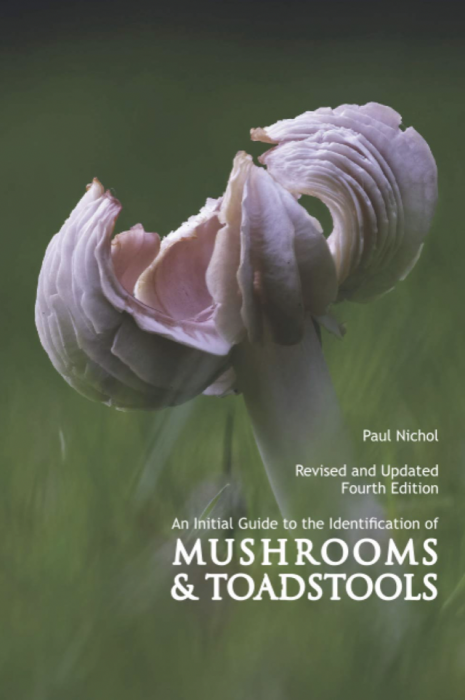
This book will not tell you what species of mushroom you have found, but it is invaluable for placing your find into the correct family of mushrooms, which is always the first step towards identification. Once you know the family group of your mushroom, you can try to match it up visually by comparing it to photographs in full identification guides. You will go mad if you just try to look through guidebook photos for things that look a bit like your specimen!
This is an easy-to-use mycological key, that takes you through a series of YES/NO questions about the observable features of your specimen until you arrive at a genus. No microscopy is required, but you will probably need to do spore prints to use it properly.
Strengths:
- The best fungi key out there for those beginning to explore fungi
- Good for working out which genus (family group) of mushrooms you are looking at
- Simple to use
- Portable
- Includes information on mushroom anatomy such as gill attachments, cap textures, how to do spore prints etc
- Promotes an understanding of the key characteristics of important fungi families that will underpin all future learning
- A brilliant foundation for mushroom identification using other resources
- Cheap
Weaknesses:
- Not an ID guide (and isn’t trying to be!)
- Will not identify your mushroom to species level – you will require an identification guidebook to complete this process (see below)
Mushrooms
Roger Phillips (£20)
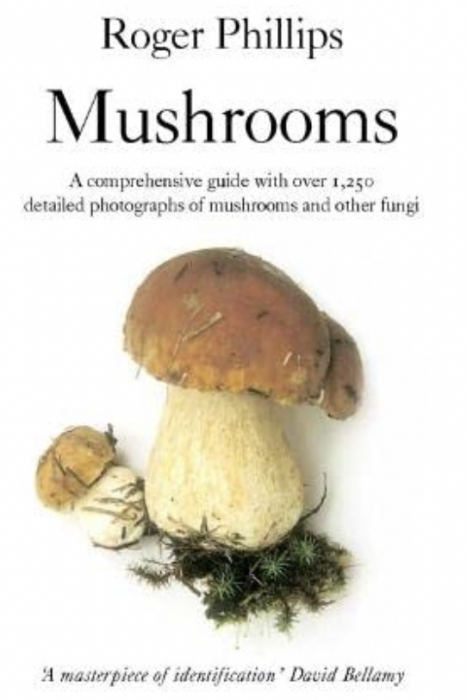
Since its first edition in 1981, this has long been the go-to text for those seeking to identify more than just basic edible and poisonous mushrooms in the UK. Identification guides have come on in leaps and bounds over the past few decades, and many of these owe a debt to the groundbreaking photography and clear layout of this book. Very few have equalled it. It still remains one of the best photographic guides to fungi in the UK, and has inspired generations of mycologists – both amateur and professional.
Note: The original version of this book (published in 1981) called “Mushrooms and Other Fungi of Great Britain and Europe” was my first proper mushroom book, and remains my favourite. It is still available second hand. It is as good as (and in some ways better than) the 2015 revision that I’m reviewing here, though quite a few of the binomial names it uses are now out of date. The original includes a list of the 25 most common fungi found on British Mycological Society forays, which I think is extremely useful, but it was (sadly) omitted from the revised edition (I’ll blog it some time – and I feature many of its species my Webinar “20 Common, Poisonous, Medicinal and Delicious Mushrooms to Learn Before You Die!” ). The original imprint was a little less compact in size.
I was lucky enough to hang out in the New Forest with Roger Phillips a few years before his death in 2021. He was warm and generous with his time and knowledge, gloriously charming and eccentric. I took the chance to ask him what inspired him to write this book. His answer I find very inspiring: “Because I knew absolutely nothing about fungi!”
This may be a slight under-exaggeration, but at the time he made the book Roger was certainly no mycologist, and nor did he claim to be. He was a gifted and imaginative photographer.
His modus operandi for making the book was to attend every British Mycological Society foray he could for several years, at which he would set up a booth with all his photographic equipment – including light boxes, which account for the incredible consistency throughout the book. He would then get the mycologists on the forays to talk him through what they had brought back, and took copious notes as he photographed their specimens.
So the book is really the beautifully photographed and organised work of many talented mycologists, and perhaps its only flaw was not to mention and accredit the scores of people who helped in its making. Occasionally I meet mycologists who are a little grumpy about this, but most are grateful for his contribution to the identification and popularisation of fungi.
Strengths:
- Excellent, clear, full-colour, close-up photographs of mushrooms – often in various stages of growth and from various angles/sections
- Precise descriptions
- Covers all the species (1250) you are likely to encounter in the UK
- Information on edibility (limited)
- Notes on UK distribution/habitat
- Good visual key to aid identification
- Good index of both common names and binomial names
- Well organised by genus
Weaknesses:
- Dry, unexpansive text provides little foraging information or inspiration for beginners
- Little coverage on eating wild fungi beyond “Excellent/Edible/Inedible/Suspect/Poisonous/Deadly”
- Wide range may overwhelm novices
- Lacks a good written key
An invaluable reference book to aid identification at home, but a little too big to be used in the field. Highly recommended, used in conjunction with “An Initial Guide to the Identification of Mushrooms and Toadstools” by Paul Nicol (see above)
Mushrooms – River Cottage Handbook No1
by John Wright (£14.99)
A small hardback by River Cottage’s affable wild food expert.
This book is a real joy. John writes with warmth, affection, deep practical experience and humour about fungi, bringing to life their beauty, magic and quirkiness with fun and lots of great facts. So engaging is his writing style, that this book would make great bedtime reading – not something I’d say about any other fungi guides (unless you were trying to get to sleep quickly!). Its like going foraging with a kind and patient grandparent, as John gently guides you through key mushroom characters. While the book is focussed on edible and poisonous species in particular, it never feels like John is dismissing the wider importance of fungi.
Strengths
- Highly entertaining and informative
- Lots of fascinating, useful and inspiring background information, fungi lore and science about both individual species and mushroom hunting in general
- Food-focussed with a great recipe section
- Substantial section covering important poisonous species
- Will not overwhelm beginners with too many inedible species
- Excellent colour photography
Weaknesses
- Little information on national distribution
- A list and some coverage of very common species would have been a nice addition
- Not a proper ID guide
A really excellent introduction to picking wild mushrooms for the table. Highly recommended, especially in conjunction with “Mushrooms” by Roger Phillips, and “An Initial Guide to the Identification of Mushrooms and Toadstools” by Paul Nicol (see above)
Mushrooming With Confidence
Alexander Schwab (£16.99)
An unusual fungi guide in that it doesn’t cover any poisonous, inedible or even non-delicious fungi. Instead it has lots of detailed photographs and ticklists for positive identification of 25 of the best and most common edible species. Mushrooming Without Fear by the same author is a slimmed down version of the same book covering even less species.
Strengths
- Lots of detailed pictures and descriptions of each species
- “Foolproof” tick-list for positive identification of each fungi
- Will not confuse beginners with look-alike mushrooms
Weaknesses
- Promotes a narrow view of fungi
- Ignores many common species – if you only have this book you won’t be able to identify 99% of the mushrooms you encounter
- Despite the detail, novices tend to try to make what they find fit what is in their book (ie. you don’t know how much you don’t know!) – which could lead to trouble.
- Includes Sheathed Woodtuft without mention of the very similar funeral bell. Regardless of precise checklists, I think this is potentially dangerous in a book aimed at novices
I have mixed opinions on this book. While the emphasis on positive identification is to be applauded, the narrow range covered means I only recommend it in conjunction with wider-ranging fungi guides.
Mushrooms & Toadstools of Britain and Europe
Black’s Nature Guides
£9.99
A compact field guide covering 360 species of fungi.
Strengths
- Pocket-sized – a true field guide
- Excellent combination of colour photographs and illustrations to aid identification
- Great snippets of expert advice and interesting facts about each species
- Notes on habitat and geographic distribution (including European distribution)
- Notes on edibility and poisonous lookalikes
- Well organised, clear and packs a lot into a small space
- Cheap*
Weaknesses
- No recipes or cookery tips beyond basic safety
- European coverage means that it includes some species that don’t occur in the UK, and can be a little misleading around abundance/distribution
Highly recommended as a ‘first-stop’ field guide – this is the book I use when out in the woods.
* This book now seems to be out of print and i’m told that second hand copies are selling for up to £100!!! Its good, but not that good!
Field Guide to Mushrooms and other Fungi of Britain and Europe
(£7.99)
A small paperback with a hard-wearing waterproof plastic cover detailing 200 species.
Strengths
- Lightweight, very compact and hard-wearing – a true field guide
- Excellent combination of colour photographs and illustrations to aid identification
- Clear and well laid out
- Cheap
- Notes on edibility and lookalikes for every species covered
Weaknesses
- No recipes or cooking tips
- Very little extra information on science, uses etc
- No information on geographic distribution
An excellent field guide, but not as good as Black’s Guide (above).
Collins Complete Guide to British Mushrooms and Toadstools
Paul Sterry and Barry Hughs (£16.99)
A hefty glossy paperback photographic guide covering over 1000 British fungi.
Strengths
- Covers every fungi you are likely to encounter in the UK
- Detailed descriptions
- Includes excellent sections on lichenised fungi, tree identification and common species of particular habitats (eg. Oak woodland, bogs etc)
- Great chapter on the science of fungi and introduction of specific genera (eg. Boletes, Amanitas etc)
Weaknesses
- Virtually NO coverage of the edibility of species
- Most photographs show only the caps of mushrooms – this is a serious flaw, despite the accurate descriptions in the text
- Little extra information on species beyond identification
- A bit bulky to be a useful field guide
Not for beginners, but useful for more experienced foragers wishing to expand their mycological identification skills beyond the commonplace and edible. A real shame there are so few pictures/diagrams of undersides of caps etc.
Collins Fungi Guide
Stefan Buckzacki
£35
A compact, thick hardback covering over 2,400 species.
Strengths
- The most comprehensive single-volume guide to the fungi of Britain and Ireland available in the shops
- Excellent quality colour illustrations
- Detailed descriptions including spore shape
- Includes rare species
- Extensive visual key and information on detailed mycological study
- Notes on geographic distribution and rarity
Weaknesses
- Virtually NO information on edibility
- Small print (almost illegibly small) print in index
- Latin names only next to illustrations (common names in text)
- Only one idealised illustration of each species (no photographs)
- Utterly daunting for novices
- Expensive
- Too hefty to be a field guide
An excellent book for keen mycologists who wish expand their knowledge and identify rare species. Ironically more complete than Collins Complete Guide (above)!
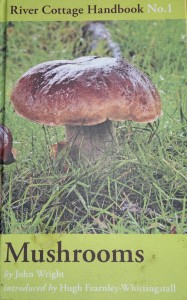
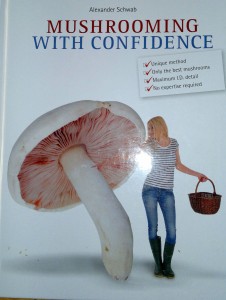
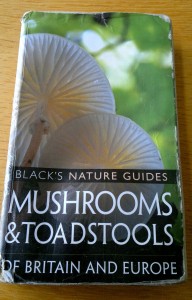
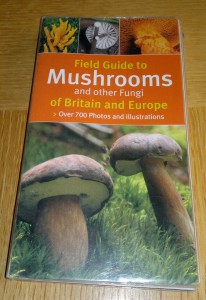


8 Comments
Great info
I am looking to forage for mushrooms and would like to ask you in your opinion what would be the best field book I could buy to help me ID edible Mushrooms and fungi.
Cheers
Scottish Bushman
On you tube
Hi Andy,
I’ve reviewed some here…not quite sure what more I can do..?
Hi Mark,
Thanks for the above information, it seems very concise.
I don’t suppose you may know where i can pick up a copy of the Black’s Nature Guides? I’m really struggling to find one anywhere and your alternative suggestion “Field Guide to Mushrooms and other Fungi of Britain and Europe” appears to have shot up in price (£52 is the cheapest i can find would you believe it)
cheers
Lewis
Just bought the John Wright book and about to buy Black’s too this was so useful! I’m a complete novice and I can’t wait to get started
Thank you for this list – and an excellent introduction to the subject.
However the page is dated 2012, and I have just bought a copy of Phillips Mushrooms (2006). Your recommended edition appears to be 1981. Books change (for better and worse) in each edition.
It would be useful to provide such bibliographic information.
I know it is difficult, but it would also be useful to provide guidance on using websites/apps. The quality of information is highly variable, but it is increasingly the main, indeed only, source of information for many people. They don’t own books. Perhaps start with a checklist of features and a couple of competency tests. For example – any identification guide for a chanterelle (or any “edible” fungus) should have references/links to ?6 possible misidentified fungi.
Thanks. As you say, its hard to keep up. But I have now added a note on the updated edition. 🙂
Hi Mark,
Thanks for the information, an extremely useful starting point. I have ‘Mushrooms’ by Roger Phillips, and have ordered the key by Paul Nichol, and I’m looking for a field guide which contains geographical distribution and covers Europe (I am currently in southern Germany and don’t speak good German). I have looked for ‘Mushrooms of Britain and Europe’ (Black’s Nature Guides), but it is apparently out of print. Would you have any suggestions for a field guide which covers Europe and includes information on geographical distribution?
Thanks again,
Ed
Sorry, I don’t know any English language fungi guides that include European distribution.